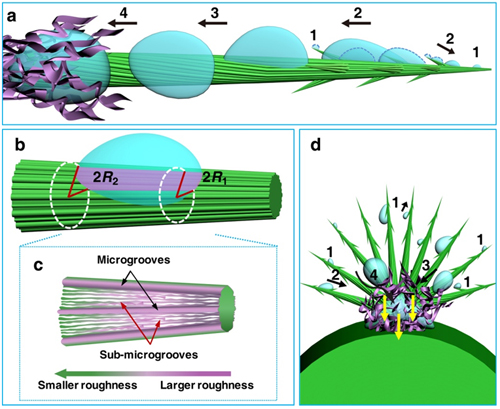Continuous and Efficient Fog Collection System discovered in Cactus
Water is the source of life. However, with the boost of the global population and the sharp increase of the industrial water consumption, water resource is getting into crisis in the world wide. Therefore, the problem of water crisis has to be tackled urgently.
The traditional Desalination and secondary recovery of waste water both require complex equipments and are high cost. Fog collection, a method to translate the latent water (water drops with diameters ranging from 5 to 40 micrometers) into the dominant, available water, is simple and low cost and is expected to solve the water crisis.
With the support from the Chinese Academy of Sciences, National Natural Science Foundation, researchers from the Key Laboratory of Organic Solids,Institute of Chemistry, cooperating with the researchers from Beihang university, get new breakthrough in the continuous and efficient fog collection after discovering the directional water collection ability of spider silk for the first time in the world (Nature 463: 640-643). This work has been published recently in Nature’s child magazine Nature Communications in Article format (Nat. Commun.2012,3: 1247)(http://www.nature.com/ncomms/journal/v3/n12/full/ncomms2253.html)and reported as the “Featured Image” of the current issue. As soon as the result was published, the Science magazine made a special news report on it named “Thirsty Cacti Collect Fog on Spines” (http://www.sciencemag.org/content/338/6113/1401.full).
The researchers studied the drought-tolerant cactus Opuntia microdays originating from the Chihuahua desert systematically. They found that the cactus had evolved unique structural features: the plump and succulent stems of it are covered evenly with clusters of spines and trichomes. A single conical spine can be divided into three parts with different subtle structures: the tip with oriented conical barbs; the middle with gradient grooves; the base with belt structured trichomes (see Figure 1).

Figure 1 Morphology of the cactus (Opuntia microdasys) and the structures of a single spine of it.(Image by JU Jie)
The integration of the structures gives rise to the integration of the multiple functions. Specifically, when the fog flows to the spine, tiny water drops deposited on the tip of it are collected through frequent coalescence, and then they are transported via the grooves with width gradient in the middle part, finally absorbed as soon as they contact with the trichomes at the base. Meanwhile, the new born fresh surface starts next cycle for water drop deposition-collection-transportation-absorption. The quick transport and depart of the water drops collected grantees the continuous fog collection.
Further analysis of the mechanism underlying show that the gradient of Laplace pressure arising from the conical shape of the spines and barbs and the gradient of surface free energy arising from the gradient of the grooves along the spines cooperatively drive the water drops to move towards base of the spine with high speed (see Figure 2). Investigation on the structure-function relationship provides new idea of designing and fabricating continuous and efficient fog collectors. It also offers a new avenue to relieve the global water crisis and benefits to the development of the global agriculture, industry as well as military.

Figure 2 Illustration of the continuous fog collection and the mechanism underlying. (Image by JU Jie)





